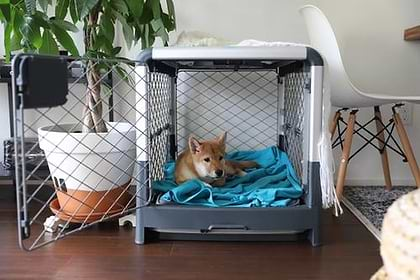Diggs’ Comprehensive Guide to Crate Training
So you’re starting the crate training process for your dog, huh? While it might seem like an arduous undertaking, we’re certain that your efforts will pay off and both you and your pet will be left feeling very content. To help you get started, Diggs has put together a step-by-step dog crate training guide that’ll facilitate the task, making it less challenging and more fun. Consider this an opportunity to bond with your canine companion!
Quick Tips for Crate Training Your Dog
What is Crate Training: Crate training leverages your dog’s natural denning instincts to provide a safe space that they can call their own. It’s a process that can help with house training, reducing anxiety, and keeping your pup safe when unsupervised.
Why Crate Train: It helps with managing behavior, travel, and creating a consistent routine for your pet, which can be especially comforting in new environments.
Essentials for Crate Training:
- A high-quality crate like Diggs' Revol or Evolv.
- Age appropriate crate bedding for a cozy environment.
- Toys and treats to foster a positive crate experience.
- Patience and a consistent routine!
Before you Bring your Pup Home, Choose your Crate
Selecting the perfect crate is all about finding the balance between your needs and your dog’s comfort. At Diggs, we design all of our crates to enhance both your lifestyle and ensure your pup's wellbeing. Engineered with premium materials, our crates boast innovative features and modern designs that blend effortlessly into your home.
Introducing the Crate
Start by allowing your dog to explore the crate at their own pace without closing the door. Place treats and their favorite toys inside to encourage exploration. Feed your dog their meals near the crate initially, then inside it to create a strong positive association.
- Pro-tip: Using Diggs’ Groov to offer treats to your pup in their crate, and even parts of their meals, helps make crate training simple! Groov was specifically designed with crate training in mind, and is durable enough to stand up to the challenges of puppy training and teething.
Creating a Positive Environment
Use verbal praise and treats to reward your dog for entering the crate. Place the crate in an area where the family spends a lot of time to avoid feelings of isolation. Make it comfy with a Diggs bed, and familiar items that smell like home.
Establishing a Routine
Consistency is key. Set regular times for your dog to eat, play, and use their crate. This predictability helps your dog feel secure and aids in quicker adaptation to the crate.
Crate Training While You're Home
Begin crate training when you're at home to avoid your pup associating the crate with being alone. Stay close by and gradually increase the time your dog spends in the crate with the door closed.
Leaving Your Dog Alone
Once your dog is comfortable, start leaving them crated for short periods when you leave the house. Gradually increase the time as they become more accustomed to the crate.
Overnight Crate Training
Place the crate in your bedroom at night or in a common area with a piece of your clothing to provide comfort. Ensuring your pup has had enough exercise and a chance to relieve themselves before bedtime, helps everyone settle in for a peaceful night.
Addressing Whining or Barking
If your dog whines or barks in the crate, wait until they're quiet before letting them out to avoid reinforcing the behavior. You don’t need complete silence for an extended time here, just a couple minutes of quiet time before being let out is plenty.
- Pro-Tip: A tired pup is a calm pup, so this is where exercise and play before crating can be a big help during training!
Troubleshooting Common Issues
If your dog is reluctant to enter the crate, go back a few steps in the training process and move at a slower pace. Never force your dog into the crate or use a crate as punishment, as this can cause anxiety and make crate training much more difficult.
Some dogs adapt more quickly to crates than others, and always remember that there is nothing wrong with looking for professional help here. Crate training can be hard and frustrating, particularly with older dogs not used to a crate, and working with a pro can make the process more manageable for both you and your pup.
Conclusion
By following these steps, you’ll help your dog to see their crate as a safe and enjoyable space. Remember, every dog is different and the key is to be patient and consistent with your training.
Sources:
How to Crate Train Your Dog in Nine Easy Steps | American Kennel Club
Crate training 101| Humane Society
How To Crate Train Your Dog | Paws
Crate Training Your Puppy or Adult Dog: Everything You Need to Know | Preventative Pet

The Diggs Team
We believe our dogs deserve safer, better designed pet products.
You might also like
Crate training tips, stories and inspiration
View all blogsIn Your Diggs
Share your photos with #DiggsPet and tag us @DiggsPet on IG and TikTok.



